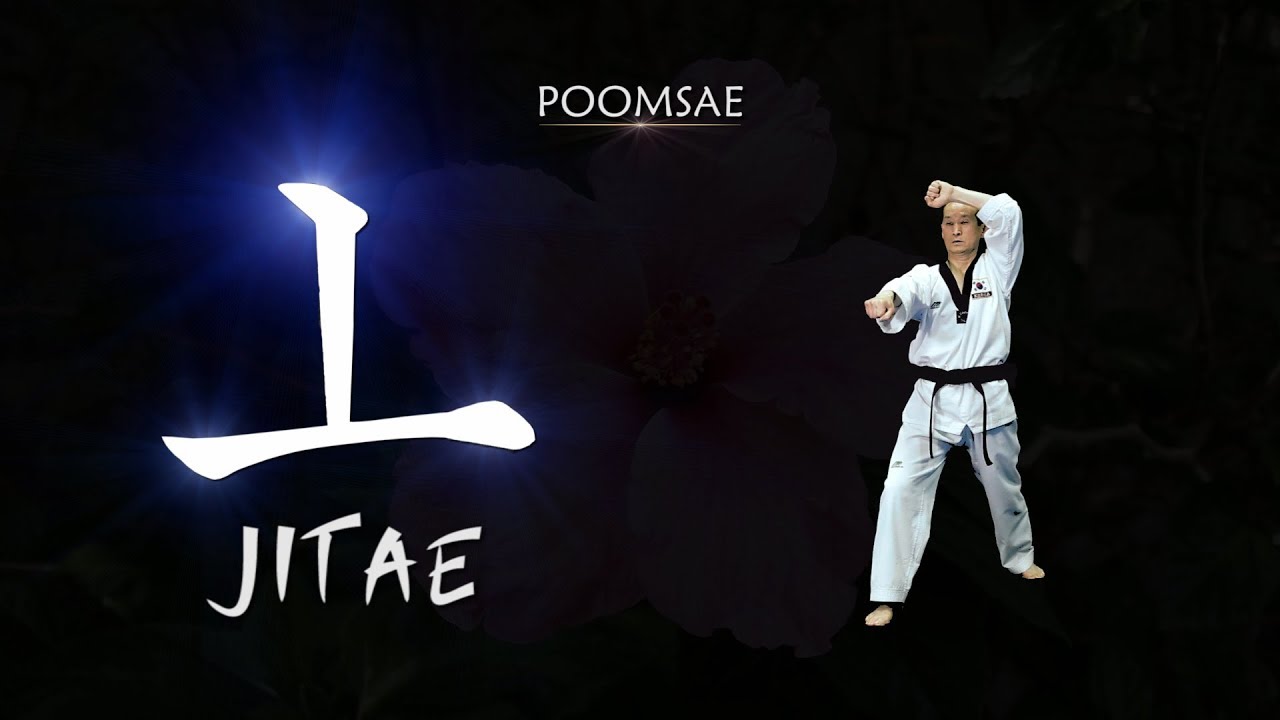The Poomsae Chitae is the 6th superior poomsa or pumsae.
Poomsae are the forms and schemes of Taekwondo that are made up of various techniques and movements such as hitting, kicking or blocking, in order to learn the basic movements of taekwondo fluently.
Among several of these schemes are the superior poomsaes, which are practiced for the promotion of Dan degrees (black belt) of the World Taekwondo Federation, and they are 9: Koryo, Kumgang, Taebek, Pyongwon, Shypchin, Chitae, Chungkwon, Jansu and Ilyo.
[adsense]
The Poomsae Chitae represents the earth and its connection with the sky, it is composed mostly of slow and explosive movements, this form should show the vigor of life, since it comes from the power that springs from strong muscles and a deep and powerful core (thus representing earth, sky, and life).

Which movements take place in the Poomsae Chitae?
The Poomsae Chitae has 28 steps or sequences that in turn contain more than 30 different techniques, each movement symbolizes constant strength and contains accurate and explosive movements that need to be executed with great concentration, among the most used movements in this Poomsae are the blocks , which have to be executed slowly, but with strength.
Among the most used techniques, we can find several locks such as the Olgulmaki (high locks), the Montongbakatmaki (out locks) or the Jansonal are maki (low locks).
Various attack movements are also used such as the front kick or direct punches (Montong baro jirugui)
Sequence scheme
First to the left direction (Da)
– You start from the starting pose (Joonbi)
Sequence 1:
Perform a step forward with left foot and execute an outward block (Montongbakatmaki) with left arm.
Sequence 2:
Slowly step forward with your right foot and forcefully execute a high right block, i.e. an upward block (Olgulmaki), without stepping, quickly return your right hand to your waist while executing a left strike (Montong baro jirugui).
[adsense]
Then towards the right direction (Ra)
Sequence 3:
Take a step with your right foot and turn 180 degrees clockwise to the left and make a block (bakatmaki) to the right.
Sequence 4:
Slowly take a step forward with your left foot and execute a left high block (Olgulmaki), without stepping, slowly and forcefully executes a blow with the right hand (Montong baro jirugui).
Then towards the front direction (Ga)
Sequence 5:
Take a step with his left foot and turns 90 degrees counterclockwise and executes a left low block (Jansonnal are maki).
Sequence 6:
Without pauses, slide your left foot back a few inches and execute a high block with the palm of your hand open (Jansonnalolgulmaki).
Sequence 7:
With the left foot fixed, perform a front kick with the right leg, put the right foot back down (left foot will be forward) and perform a double block with the palms of the hands open (Sonnal are maki).
Sequence 8:
Without stepping, slowly and powerfully execute an external block (Bakatmaki) with the right hand.
Sequence 9:
With the right foot fixed, execute a left front kick, place the left foot back on the floor (with the left foot facing forward) and execute a double low block with open hands (Sonnal are maki).
Sequence 10:
Slide your left foot again and slowly execute a high block (olgulmaki)
Sequence 11:
Going forward with the right foot one step, lower the left arm, execute a diamond blow (Keumgangapjireugi), this is done by making a high block with one hand and with the other punching.
Sequence 12:
Without stepping, execute a Left inner block (Momtongmaki), then quickly execute an inner block to the right.
Sequence 13:
Step back with your right foot one step (left foot will be forward) and execute a low block with open left palm (Jansonnal are maki).
Sequence 14:
With the left foot fixed, execute a right front kick, put the right foot back down and perform a double strike, striking first with right hand and then left hand.
Sequence 15:
Turning 180 degrees counterclockwise, execute a double high block (Hwangsomaki), that is, a block with both arms above the head.
Sequence 16:
Without stepping, execute a low left side block.
Sequence 17:
Without stepping, rotate the upper body 90 degrees to the right and execute a low open palm block with your right hand (bakatmaki).
Sequence 18:
Without stepping, execute a left hammer blow (mejumeokpyojeokchigi), this is carried out keeping the right arm to one side, while the left arm leaves that same side, launching a blow with the arm in an upright position.
Sequence 19:
Raise your right leg into the crane position and execute a right low block (Jansonal are maki).
Sequence 20:
Without stepping, he executes a small hinge block (Jageundoltzeogi), pivoting on the left foot, executes a right side kick.
Sequence 21:
Place your right foot next to your left foot, then lift your left leg into the crane position and execute a left low block (Jansonal are maki).
Sequence 22:
Without stepping, run a small hinge block.
Then in the previous direction (Na)
Sequence 23
Pivoting with the right foot, he executes a left side kick.
Sequence 24:
Step forward with your right foot and execute a right blow.
Sequence 25:
Turning 270 degrees counterclockwise, move your left foot forward one step and perform a low block with open palm (Jansonal are maki).
Sequence 26:
Step forward with your right foot and perform a double block with open palms (Momtangmaki).
Sequence 27:
Turning 180 degrees clockwise, move your right foot forward one step and execute a double low block with open hands (Sonnal are maki).
Sequence 28:
Step forward with your left foot and execute a double block with open hands (Momtangmaki). – Moving the left foot, return to the starting position.
[adsense]
POMMSAE CHITAE SCHEME

Execution of POMMSAE CHITAE
Execution carried out by the Spanish World Champion Master Alberto Delgado
POOMSAE ANALYSIS
It is recommended to train the jump between yop chaguis to maintain the balance of the sequence. Extend the jump one step in order to finish the pommsae in the same place where it started.
[adsense]
The Superior Poomsaes
We have 9 top Poomsaes. These poomsaes are those required by the WT Taekwondo Federation for promotion to DAN degrees.
- Poomsae Koryo
- Poomsae Kumgang
- Poomsae Taebek
- Poomsae Pyongwon
- Poomsae Sypcchin
- Poomsae Chitae
- Poomsae Chungkwon
- Poomsae Jansu
- Poomsae IIyo
👉🏼👉🏼 Share this 💚💚🙏🏻🙏🏻:
